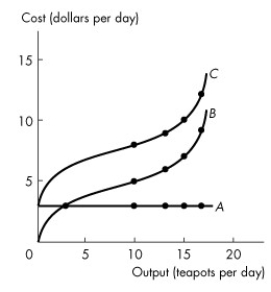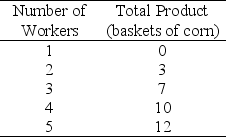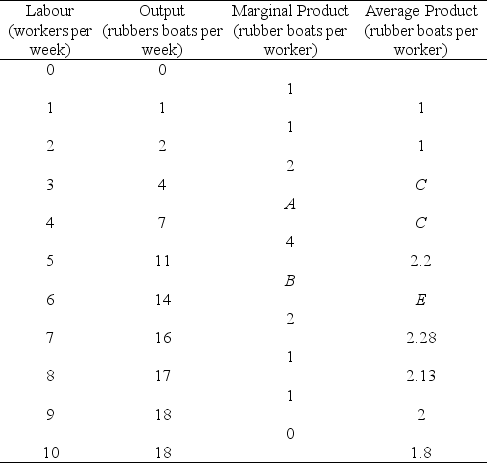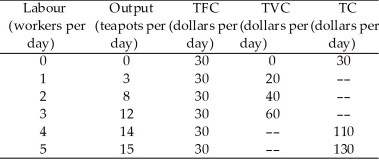A) $7.86.
B) $6.75.
C) $7.
D) $1.75.
E) $27.50.
Correct Answer

verified
Correct Answer
verified
Multiple Choice
The average fixed cost curve slopes downward due to
A) diminishing marginal utility.
B) diminishing marginal returns.
C) technological inefficiency.
D) economic inefficiency.
E) spreading total fixed cost over increasing output.
Correct Answer

verified
Correct Answer
verified
Multiple Choice
The short run refers to a time period
A) of one year or less.
B) in which all factors of production are variable.
C) in which all factors of production are fixed.
D) in which some factors of production are variable,but at least one factor of production is fixed.
E) in which all factors of production are variable,but the technology is fixed.
Correct Answer

verified
Correct Answer
verified
Multiple Choice
One reason for diseconomies of scale is that as output becomes larger and larger,
A) costs per unit decrease.
B) management systems become more efficient.
C) the number of workers increases.
D) management systems can become more complex and inefficient.
E) workers become more efficient.
Correct Answer

verified
Correct Answer
verified
Multiple Choice
Which one of the following is false?
A) The marginal cost curve intersects the average variable cost curve and the average total cost curve at their maximum points.
B) When marginal cost is greater than average variable cost,average variable cost is increasing.
C) When marginal cost is greater than average total cost,average total cost is increasing.
D) The average total cost curve is U-shaped.
E) The average fixed cost curve is downward sloping.
Correct Answer

verified
Correct Answer
verified
Multiple Choice
Use the figure below to answer the following question.  Figure 10.3.1
-Refer to Figure 10.3.1.Which one of the following statements is false?
Figure 10.3.1
-Refer to Figure 10.3.1.Which one of the following statements is false?
A) The total fixed cost curve A.
B) Total variable cost and total cost both increase with output.
C) The vertical gap between curves B and C is equal to total variable cost.
D) Marginal cost is equal to the slope of curve C.
E) Total fixed cost is constant.
Correct Answer

verified
Correct Answer
verified
Multiple Choice
A firm's goal is to
A) maximize revenue.
B) maximize customer satisfaction.
C) maximize profit.
D) minimize costs.
E) minimize risk.
Correct Answer

verified
Correct Answer
verified
Multiple Choice
If the ATC curve is falling,then the MC curve must be
A) rising.
B) falling.
C) intersecting ATC.
D) above ATC.
E) below ATC.
Correct Answer

verified
Correct Answer
verified
Multiple Choice
A firm will want to increase its scale of plant if
A) it is persistently producing on the upward-sloping part of its short-run average total cost curve.
B) it is persistently producing on the downward-sloping part of its short-run average total cost curve.
C) it is producing below minimum efficient scale.
D) marginal cost is below average total cost.
E) marginal cost is below average variable cost.
Correct Answer

verified
Correct Answer
verified
Multiple Choice
Use the table below to answer the following question.
Table 10.2.4
 -Refer to Table 10.2.4.The table gives the total product schedule of workers who harvest corn.Diminishing marginal returns begin when the ________ is hired.
-Refer to Table 10.2.4.The table gives the total product schedule of workers who harvest corn.Diminishing marginal returns begin when the ________ is hired.
A) 1st labourer
B) 2nd labourer
C) 3rd labourer
D) 4th labourer
E) There are no diminishing marginal returns since total product always rises.
Correct Answer

verified
Correct Answer
verified
Multiple Choice
If the average variable cost of producing 10 units is $18 and the average variable cost of producing 11 units is $20,we know that,between 10 and 11 units of output,
A) marginal cost is increasing.
B) average total cost is increasing.
C) average fixed cost is increasing.
D) total cost is either increasing or decreasing.
E) average total cost is minimized.
Correct Answer

verified
Correct Answer
verified
Multiple Choice
Use the table below to answer the following questions.
Table 10.2.3
 -Refer to Table 10.2.3.The maximum value of marginal product occurs where output equals ________,while the maximum value of average product occurs where output equals ________.
-Refer to Table 10.2.3.The maximum value of marginal product occurs where output equals ________,while the maximum value of average product occurs where output equals ________.
A) 5;6
B) 6;5
C) 7;14
D) 9;14
E) 14;11
Correct Answer

verified
Correct Answer
verified
Multiple Choice
Flora's Flowers bought a new van last year for $10,000.It can now sell the van for $8,500.To buy this year's model of the same van it would have to pay $11,000.What is the one-year amount of economic depreciation?
A) $2,500
B) $1,500
C) $1,000
D) $10,000
E) $3,500
Correct Answer

verified
Correct Answer
verified
Multiple Choice
Economic depreciation is
A) the same as depreciation calculated by an accountant.
B) equal to economic profit minus normal profit.
C) the change in the market price of capital over a given period.
D) the deterioration of the physical appearance of a capital.
E) paid in cash.
Correct Answer

verified
Correct Answer
verified
Multiple Choice
Which one of the following statements is true?
A) The highest value of average product occurs where average product is greater than marginal product.
B) When the average product curve is rising,marginal product is less than average product.
C) When the average product curve is falling,marginal product is greater than average product.
D) The maximum total product occurs at minimum marginal product.
E) The highest value of average product occurs where average product equals marginal product.
Correct Answer

verified
Correct Answer
verified
Multiple Choice
Suppose a 1-unit increase in labour,from 2 to 3 workers,increases output at a woollen mill from 10 to 15 sweaters.The marginal product from the increase in the quantity of labour is
A) 1 sweater.
B) 3 sweaters.
C) 10 sweaters.
D) 5 sweaters.
E) 15 sweaters.
Correct Answer

verified
Correct Answer
verified
Multiple Choice
Use the table below to answer the following questions.
Table 10.3.2  -Refer to Table 10.3.2,which gives Tania's Teapots' total cost schedule.When output increases from 8 to 12 teapots,the marginal cost of one of the 4 teapots is
-Refer to Table 10.3.2,which gives Tania's Teapots' total cost schedule.When output increases from 8 to 12 teapots,the marginal cost of one of the 4 teapots is
A) $20.
B) $5.
C) $1.
D) $6.67.
E) $2.
Correct Answer

verified
Correct Answer
verified
Multiple Choice
A firm's opportunity cost of production is the sum of the cost of using resources
A) bought in the market.
B) owned by the firm.
C) supplied by the firm's owner.
D) bought in the market and supplied by the firm's owner.
E) bought in the market,owned by the firm,and supplied by the firm's owner.
Correct Answer

verified
Correct Answer
verified
Multiple Choice
Which of the following quotes best illustrates the idea of average product?
A) "If I have 10 workers on my assembly line,I can produce 13 tables a day."
B) "If I add an 11th worker,I can produce 1 extra table a day."
C) "Each worker produces 2 tables a day."
D) "I find if I add an extra shift at night,table production only rises by 80 percent because I need more maintenance time on the assembly line."
E) "If I double workers and double the assembly line,I can make 120 percent more tables."
Correct Answer

verified
Correct Answer
verified
Multiple Choice
Which one of the following statements is false?
A) Average total cost is total cost per unit of output.
B) Average fixed cost plus average variable cost equals average total cost.
C) Marginal cost is the increase in total cost resulting from a one-unit increase in output.
D) Total cost equals fixed cost plus average cost.
E) Marginal cost depends on the amount of labour hired.
Correct Answer

verified
Correct Answer
verified
Showing 101 - 120 of 145
Related Exams